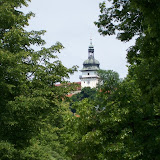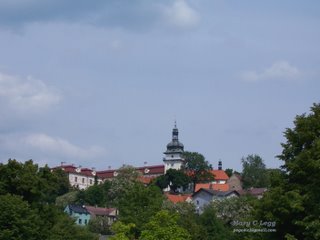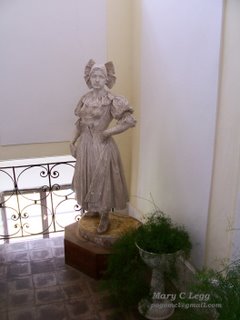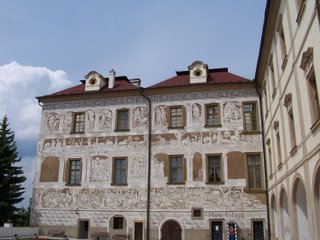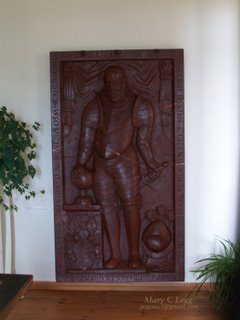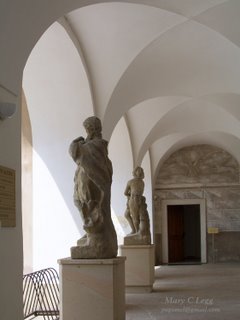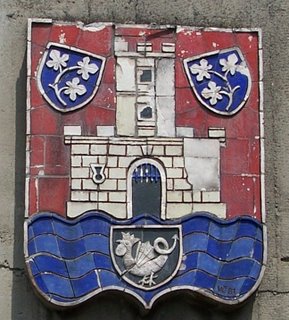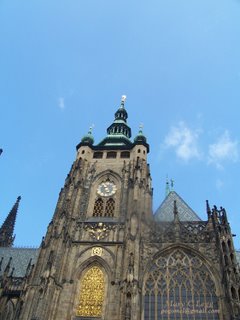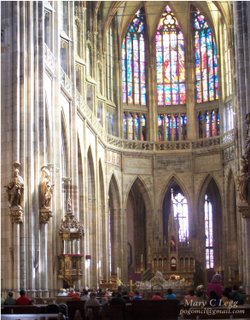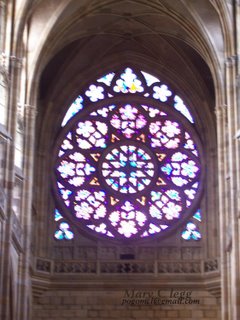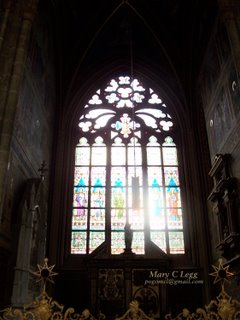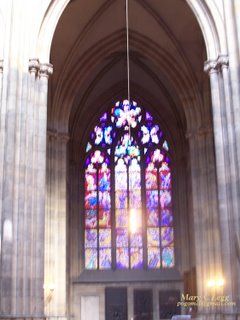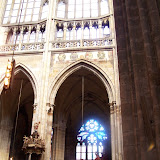The Grapes of Drazic
and Basilisk of Vrazda
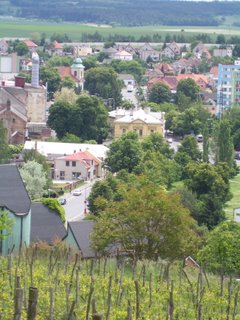
Benatky nad Jizera lies approximately 30km northeast of Prague on important trade routes crossing east and west in an area that was settled by Celts in pre-Christian times. The first mention of it appears around 1052 as the town, Obodr. In 1356, Jan of Drazice applied to build a town with a monastery at the crest of the hill. The church of the Assumption of the Virgin Mary was built in 1349 adjacent to the new found monastery. The village of Drazice is within walking distance from Benatky where ruins from the ancient castle can be found.

The Benatky arms include two shields bearing three golden grapeleaves on a blue background, representing the Drazic heraldry. The Drazic nobility provided at least three Bishops of Prague and the first Archbishop of Prague.
Jan 1 Bishop of Prague 1134-1139
Jan II of Drazice 1227-1236 bishophry
Jan III of Drazice 1258-1278 bishophry
Jan IV of Drazice 1301-1345 bishophry
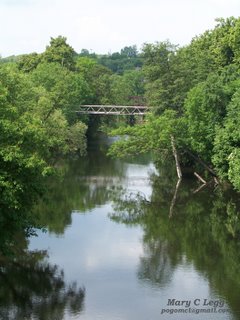
The Drazic arms can be seen on the Bishop's House in Prague, located on Drazicke Square on the left side of Charles Bridge in Malostrana. The Bishop's House was established as the original bishop's palace in Prague. Later Charles IV established the Archbishophry at St Vitus at the castle.
Other associations to the Drazic family include the development Cesky Brod. Under Jan I, Bishop of Prague, a marketplace was established by the church of St Gothard and a town called Biskupsky Brod, established under Jan III in 1268. The name was altered to Cesky Brod in 1315 during the occupation of the Romovs.
Jan IV of Drazic knew Pope Boniface VIII, the last pope before the Avignon Papacy. Where his loyalties lay in the struggle between church and state is not clear since he was also a friend to John of Luxemburg. John I was a strong ally of Philip the Fair who rebelled against the avaricious taxation of the Church in Rome. Philip the Fair made the succeeding pope, Clement V, his vassal and refused to concede to the superiority of the Pope over King. Charles I also maintained his independence from the papal supremacy and appointed the first Archbishop of Prague,who was also a descendent from this family.
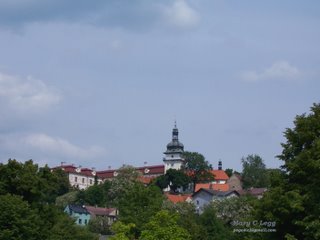
After 1385, the Drazic lineage vanished and little can be discovered. During the Hussite Wars, the monastery was destroyed. The area became Hussite territory. In 1526, Friedrich of Drazice, burgrave of Donin moved his residence to Benatky where he built the Italian renaissance palace on the hill over the ruins of the monastery.
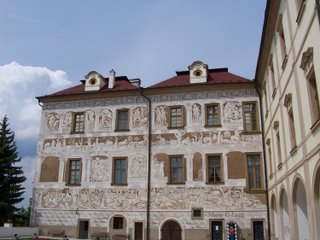
The large shield on the Benatky arms displays a castle with a rampant golden basilisk or cockatrice which represents the heraldry of Oldrich of Vrazda from Kunwald. Kunwald became the source for the stream of Hussitism known as the Unitas Fratrum, later called the Moravian Brethern. A certain John of Rokyzana gained permission from George of Podebrady to establish a new community centered with the supremacy of the Bible to Catholic ecclessiastical authority.
Ironically the town that produced three
bishops shifted allegiance with a stong following of the Bohemian Brothers ( Church of the Moravian Brotherhood), administered by John Augusta in New Benatky. Brother Lucas, the second leader of the Bohemian Brothers (Unitas Fratrum or Moravian Brothers) died in
1528 to be succeeded by John Augusta who was persecuted by the Spanish Hapsburg Ferdinand I of
Austria (1503-1564).
Ferdinand I was a staunch Catholic and intolerant of
dissenting beliefs in the Bohemian lands. In 1547, the Bohemian Estates rebelled against
Ferdinand, in retaliation of his intolerance and brutal dictatorial powers.
The combined forces of Charles V and Ferdinand defeated the
Estates.
Ferdinand imprisoned John Augusta for his leadership in the rebellion in the White Tower of Prague where he was tortured and then transferred with Bilek to Pürglitz where Ferdinand maintained a seat.
In 1551, Ferdinand I
introduced the Jesuits
into the Bohemian lands to enforce rigorous acknowledgement of Catholicism and suppress dissenting beliefs. The
Bohemian Brethern
and their associates were driven into hiding. In 1561, John Augusta was confronted in debate with the Jesuit, Jindrich Blissem. He was released from prison in 1564 and died in Jungbunzlau.
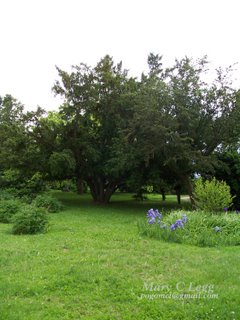
To get to Benatky
Bus from Florenc, Stand 12 7am, 7:55am, 9:20 am, 12:15pm
pay on bus, approx 45 kc one-way
Return
catch bus at Ceska Sporitelna in Benatky 18:05, 20:40, 21:40
or walk to Lysa to catch the train. 18km train ticket
Museum entrance: 20kc
Offering of postcards and mementos. Small medals range in price from 80kc for the small basilisks and 300kc for a Tycho medallion.
Open Tuesday –Sunday
9:00 – 12:00 a 13:00 – 17:00
Zámek 49, 294 71 Benátky nad Jizerou
Telefon - 326 316 682
 On a cold winter's day
when heavy clouds smother Prague, fresh fish over in the Fish Market brings back the warmth of the
Mediterranean sun Fish is delivered regularly and the menu varies accordingly. The bream comes
from Croatia, the salmon from Norway, the mussels, clams, oysters and prawns
from France and the octopus from Morocco. The Atlantic halibut and monkfish
from Norway and the turbot form Croatia, but the lobster is Canadian. Red
Snapper comes from Italy. Unlike the tourists, this is their final destination
and their appearance is exclusive for you.
On a cold winter's day
when heavy clouds smother Prague, fresh fish over in the Fish Market brings back the warmth of the
Mediterranean sun Fish is delivered regularly and the menu varies accordingly. The bream comes
from Croatia, the salmon from Norway, the mussels, clams, oysters and prawns
from France and the octopus from Morocco. The Atlantic halibut and monkfish
from Norway and the turbot form Croatia, but the lobster is Canadian. Red
Snapper comes from Italy. Unlike the tourists, this is their final destination
and their appearance is exclusive for you. Vlasatice Chardonnay
accompanied the bream. It was a good
choice made by the manager. The wine was light, a bit fruity, but not dry or
excessively sweet. It tasted like the first drops of spring rain after a cruel
winter. Although Czech wines are not so well known on the market, the area
close to the Austrian border near Slovakia is rich in vineyards that are making
a stunning revival into the international market. They are smooth and pour
easily, particularly around the time of the late harvest when the new wine
arrives in Prague in large kegs and sold
on the streets in frothy glory.
Vlasatice Chardonnay
accompanied the bream. It was a good
choice made by the manager. The wine was light, a bit fruity, but not dry or
excessively sweet. It tasted like the first drops of spring rain after a cruel
winter. Although Czech wines are not so well known on the market, the area
close to the Austrian border near Slovakia is rich in vineyards that are making
a stunning revival into the international market. They are smooth and pour
easily, particularly around the time of the late harvest when the new wine
arrives in Prague in large kegs and sold
on the streets in frothy glory. 



























